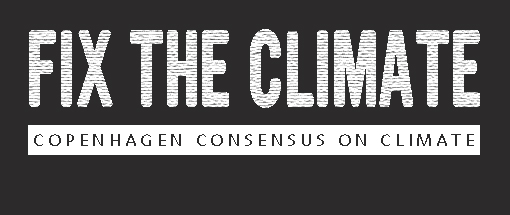Research
It is clear that human behavior is warming the planet.
Emissions of greenhouse gases like carbon dioxide form a ‘blanket’ around the planet that traps some of the heat emitted by Earth. Global greenhouse gas emissions due to human activities have grown significantly since pre-industrial times. A lot of this is caused by burning oil, coal, and gas.
An average increase in the Earth’s temperature affects the climate. A warmer earth is likely to mean changes in rainfall, melting of snow and ice, a rise in sea level, and impacts on plants, wildlife, and humans. These effects mean that global warming is a problem that politicians and citizens must confront.
Research for the Copenhagen Consensus on Climate covers eight research areas. You can explore these topics below and find links to our Assessment and Perspective Papers on each topic. They analyze the problem and propose solutions to mitigate the effects of climate change.
Engineering a Better Climate
Climate engineering could offer an extremely cheap, fast solution to climate change, according to this comprehensive analysis of its costs and benefits. An Analysis of Climate Engineering as a Response to Climate Change by Dr. Eric J Bickel and Lee Lane shows that we might be able to cancel out this century’s global warming by spending no more than $5.8 billion, and that climate engineering might be able to achieve as much for the planet as carbon cuts at a fraction of the cost.
In addition to the Assessment Paper by Bickel and Lane, two perspective papers were prepared by Dr. Anne Smith and Dr. Roger Pielke Jr.

Cutting Carbon Emissions
Climate economist Prof. Dr. Richard Tol examines the costs and benefits of cutting carbon under different scenarios.
He finds: “A well-designed, gradual policy of carbon cuts could substantially reduce emissions at low cost to society. Ill-designed policies, or policies that seek to do too much too soon can be orders of magnitude more expensive. While the academic literature has focused on the former, policy makers have opted.”
Dr. Ir. Onno Kuik and Prof. Roberto Roson provide responses in their Perspective Papers. All three are available by following the link below.

Protecting and Planting Forests
Prof. Brent Sohngen wrote an Assessment Paper on the role of plants and forests. Ecosystems store approximately 1 trillion tons of CO2 in the biomass of living trees and plants. Methods to increase this carbon efficiently in order to reduce the future damages of climate change include afforestation (planting old agricultural land in trees), reduced deforestation, and forest management.
Dr Sabine Fuss provides a response in her Perspective Paper. You can find both documents by clicking the link below.

Cutting Black Carbon Emissions
As much as 40% of current net warming is attributable to black carbon, point out Dr. W. David Montgomery, Robert E. Baron and Dr. Sugandha D. Tuladhar. Moreover, whereas CO2 has a life of up to about 40 years, black carbon remains in the atmosphere for as little as several weeks, which means that reducing emissions of black carbon can have an immediate near term impact on atmospheric warming. Since black carbon is considered responsible for about 30% of the arctic melting, black carbon emission reductions can also rapidly reduce the rate at which arctic ice is melting.
Read Montgomery, Baron, and Tuladhar's Assessment Paper, along with a Perspective Paper by Dr. Milind Kandlikar, Conor C. O. Reynolds and Andrew P. Grieshop by following the link below.

Cutting Methane Emissions
Prof. Dr. Claudia Kemfert and Wolf-Peter Schill analyze methane emission abatement options in five different sectors and identify economic mitigation potentials for different CO2 prices. Methane is a major anthropogenic greenhouse gas, second only to carbon dioxide in its impact on climate change. Methane has a variety of sources that can be small, geographically dispersed, and not related to energy sectors.
In addition to the Assessment Paper, Dr David Anthoff and Dr David Johansson & Dr Fredrik Hedenus provide two Perspective Papers. You can find all three documents by following the link below.

Adapting to Climate Change’s Effects
No matter what we do, we are unlikely to avoid all of the impacts of climate change. Adaptation is unavoidable. Adaptation is reducing our vulnerability to actual or expected climate change effects. It is mostly about thinking ahead.
Prof. Carlo Carraro, Dr. Francesco Bosello and dr. Enrica De Cian carry out an integrated analysis of both optimal mitigation (carbon cutting) and adaptation at the global and regional level in their Assessment Paper. Dr Samuel Fankhauser and Dr Frank Jotzo provide responses in their Perspective Papers.

Researching Green Energy
This research paper, by Isabel Galiana and Prof. Chris Green,considers a "technology-led approach" to mitigating CO2 emissions and stabilizing climate over the course of the 21st century. This approach would focus effort and commitments on researching and developing effective, scalable, and competitive carbon emission-free energy technologies to displace carbon–emitting ones.
Prof. Gregory Nemet and Dr. Valentina Bosetti provide Perspective Papers. All three documents are available at the link below.

Sharing Green Technology
In this research paper, Professor Yang finds that Technology Transfers are an effective and comprehensive approach for dealing with climate change, because international cooperation on both greenhouse gas mitigation and adaptation must involve transfers of technologies or dissemination of knowledge. Sharing skills, knowledge and technological breakthroughs among governments and other institutions to ensure that scientific and technological developments are accessible to a wider range of users.
Professor David Popp drafted the Perspective Paper. Both documents can be found by clicking the link below.


